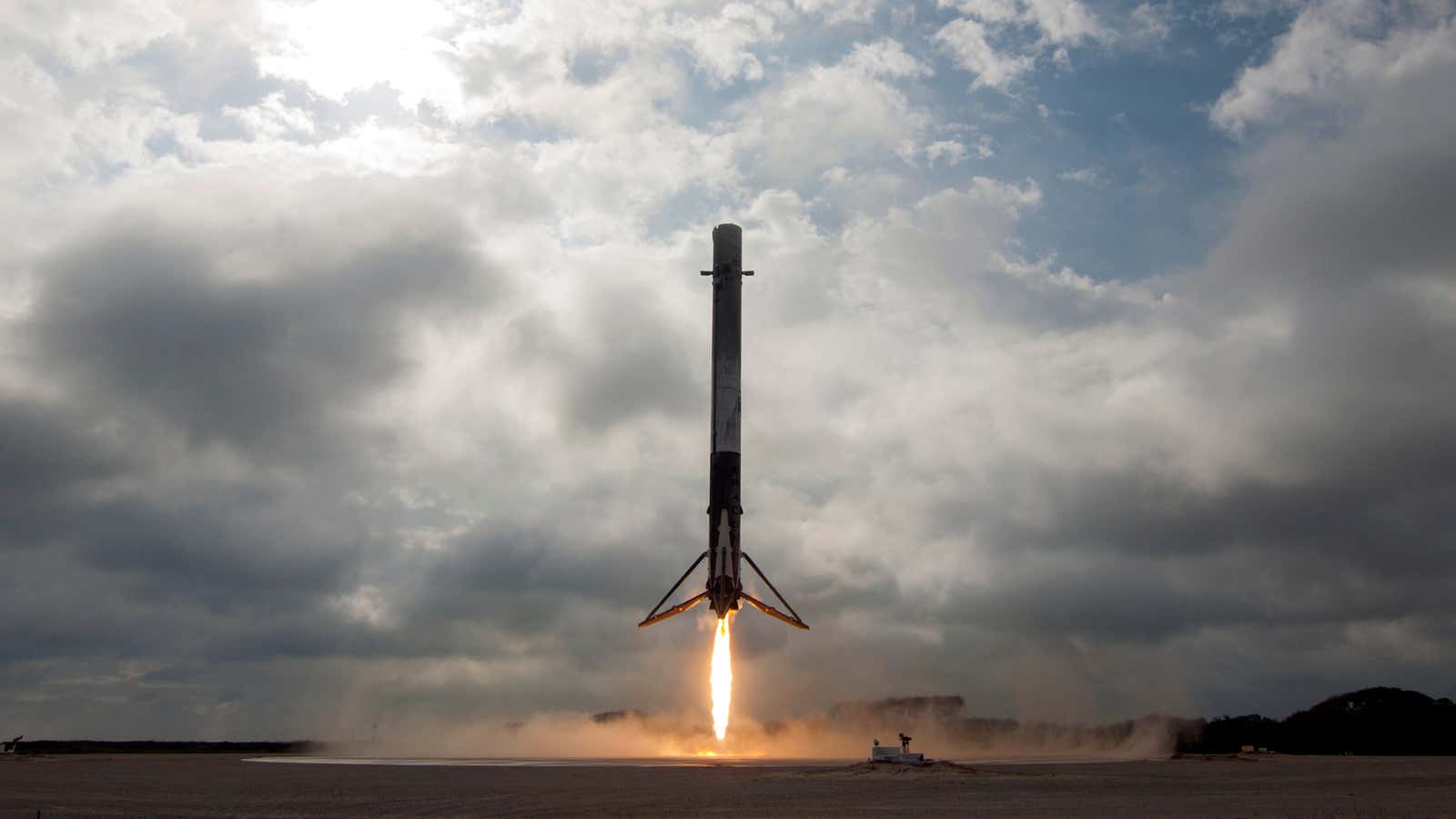In June 2017, SpaceX launched three rockets into space. It also returned the first stages of those rockets, 14 stories tall and weighing 20 tons (18 metric tons), back to earth, where they settled onto floating barges in both oceans and a landing pad at Cape Canaveral. One of those rockets had already been flown just months before, marking just the second time a commercial rocket has been reused to fly a satellite into orbit.
Reusing the first stage of a rocket, the largest and most expensive component because of its cluster of nine powerful engines, has been part of SpaceX’s goals since the beginning. The latest launches are a sign it is starting to become routine. But until recently, the mere idea was scoffed at by the most experienced players in the industry. Rockets were only economical as “expendable” systems, used once and abandoned.
“There was a chief engineer of another launch provider, I will not say the name, who told me, categorically, to my face, you will never land a first-stage booster. It is impossible, and even if you do it, it will be completely wrecked,” Martin Halliwell, the chief technology officer at European satellite giant SES, said earlier this spring, shortly before his company’s latest satellite flew on the first SpaceX rocket stage to be reused. “Never say never, eh?”
While SpaceX is still working toward its ultimate goal—a 24-hour turnaround for previously-flown rocket stages—it has come a long way since it filed a patent in 2004, just two years after its founding, for an important engine component that does not require replacement after every flight, since “reusable rockets are very desirable designs from a cost reduction standpoint.” (It is still the only patent the company owns; founder Elon Musk doesn’t believe in them.)
Here is a history of that journey, from the very first launch to the most recent landing.
The Grasshopper, 2012-2013
The first test vehicle in the SpaceX reusable flight program took a small hop for rocket-kind on September 21, 2012. The 31-meter-tall (102 feet) prototype was built around the empty tank of an early version of the Falcon 9 rocket, which had completed its own qualification program just five months before.
The US Federal Aviation Administration, which licensed the test program, didn’t let this rocket more than three-quarters of a kilometer (half a mile) into the air. But over eight test flights at a test facility in McGregor, Texas, the company was able to gather information that would inform its later experiments. This kind of testing wasn’t ground-breaking—the McDonnell Douglas company tested similar technology in the 1990s—but was a necessary step toward perhaps the most difficult part of the whole invention: Developing the software that would guide the rocket back to earth autonomously.
The final flight of the Grasshopper took place in October 2013:
The Falcon 9 Reusable (F9R), 2014
The natural next step was to get bigger and fly higher to test maneuvering the rocket in hover mode. The F9R prototype was built around the 40-meter-tall tank of the second-generation Falcon 9 rocket, and included the same kind of retractable landing legs to be used on the real thing. It flew up to 1 kilometer into the air before returning to earth:
Things went awry during a flight in August 2014. After taking off, the rocket began drifting off course. Automated software caused it to self-destruct before it could leave the safe test area. The problem was a blocked sensor, which, according to SpaceX officials, would have a redundant counterpart in an operational rocket.
Test failures are common in rocketry, but this turned out to be the last reusable flight at SpaceX’s Texas test facility—from here on out, the company would develop its reusable rocket technology on operational flights. In fact, it had begun doing that almost a year earlier.
“Test as we fly”
“SpaceX was built on ‘test, test, test, test, test.’ We test as we fly,” a SpaceX engineer told a NASA interviewer in 2013. Nowhere is that truer than in reusable rocketry, where the company regularly combined revenue-generating satellite and cargo launches with experimental efforts to recover the first stage of its rocket and test special equipment like landing legs and grid fins. When launching, rockets typically fly out over the ocean to avoid risk to people and cities; the coast guard ensures the sea is clear in that area. SpaceX used a number of early flights to practice flying its rocket home in this safe environment.

Sept 29, 2013, Cassiope
SpaceX’s first completely commercial mission was launching a Canadian satellite called Cassiope. Its engineers also wanted to test the rocket’s reusable flight abilities, so after it sent its second stage and satellite off towards orbit, it flew itself down toward the ocean before losing control and plunging to its destruction. This test took place before any of the F9R tests in Texas.
April 18, 2014, CRS-3
Just a day after the first F9R test, this is the first mission where an operational Falcon 9 flew with landing legs attached. The rocket flew itself back down to the ocean and performed a successful controlled “landing,” though into the water rather than on a floating platform.
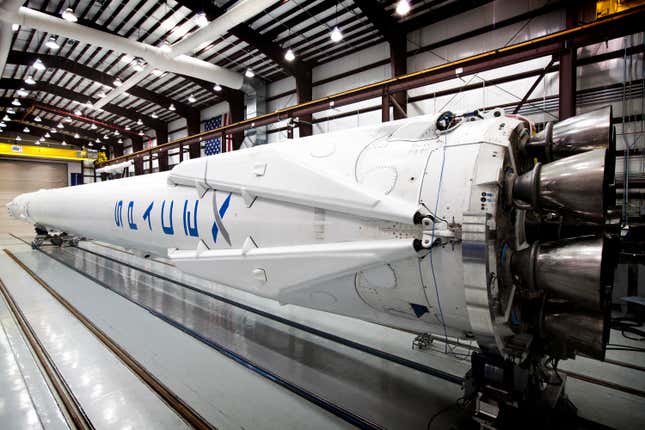
July 14, 2014, Orbcomm
In the second flight with landing legs, the rocket performed another controlled descent after launching its satellite cargo. Though the stage was eventually abandoned to the ocean, “this test confirms that the Falcon 9 booster is able consistently to reenter from space at hypersonic velocity, restart main engines twice, deploy landing legs and touch down at near zero velocity,” the company said in a statement.
September 21, 2014, CRS-4
There were no landing legs on this rocket, which carried cargo to the International Space Station. The rocket still practiced its controlled descent into the ocean before tipping over.
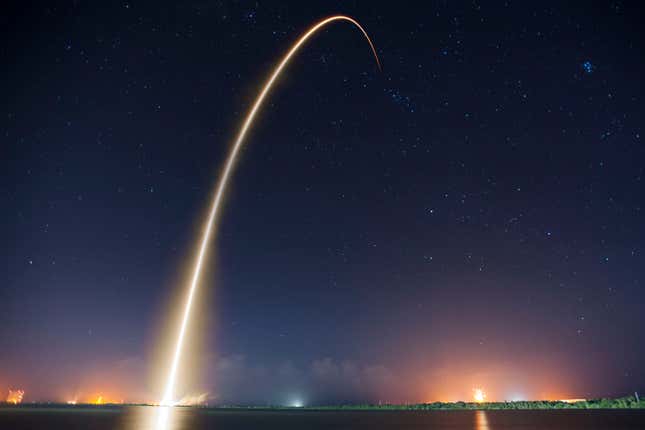
Drone ships
One of the most unusual aspects of the reusable rocket program is the use of autonomous drone ships to recover the first-stage boosters. Their function is to provide a landing platform when the rocket has to use too much fuel, either because of the weight of the satellite requires extra energy, or because the height of the orbit requires an extra boost from the first stage.
The need to land reusable rockets at sea is so important that it sparked a legal battle between SpaceX and Jeff Bezos’ space company, Blue Origin, over who had the rights to the idea. SpaceX ultimately produced the first drone ships in late 2014. There is one stationed in each ocean, and they are named after artificially-intelligent spaceships in a science-fiction series that Musk enjoys. In the Atlantic, there is Of Course I Still Love You, while in the Pacific, there is Just Read the Instructions.
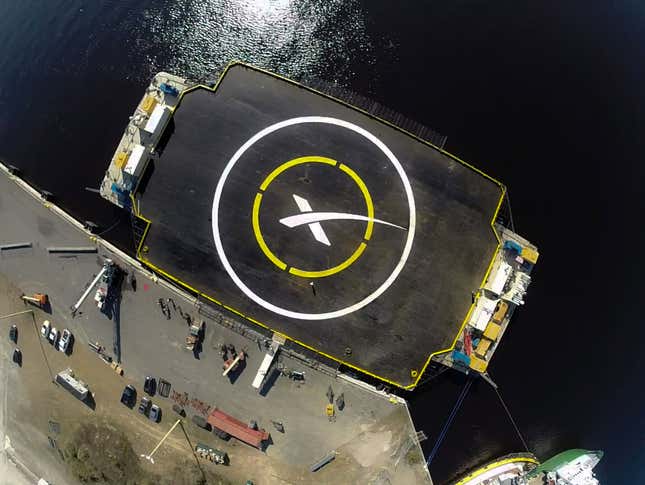
January 10, 2015, CRS-5
The first attempt to land on an autonomous drone ship ended in an explosion after the hydraulic systems controlling the grid fins ran out of fluid before the landing, causing the rocket to veer out of control and blow up. It also produced this iconic vine from the ever social-media savvy SpaceX team:
February 11, 2015, DSCOVR
This flight delivered a pretty cool satellite to a pretty cool orbit 450,000 kilometers from earth. SpaceX only performed an ocean landing test on this launch.
April 14, 2015, CRS-6
Two months later, the company made another attempt to land the rocket on its sea-going drone ship after sending another spacecraft full of science and supplies to the International Space Station (ISS). This landing was the closest yet, but a sticky throttle valve prevented the rocket from powering down as quickly as necessary. With too much lateral motion, it tipped over gently and exploded spectacularly.
Honing the technique
December 22, 2015, Orbcomm 2
In June 2015, SpaceX suffered a launch failure that grounded its rocket for almost six months. But it did not diminish the company’s audacity. In its return to flight, launching satellites for the company Orbcomm, SpaceX made its first attempt to land a rocket on a specially designed landing pad at Cape Canaveral. The rocket flew 100 kilometers up to the edge of space, sent its cargo on its way at about four times the speed of sound, then flew right back to whence it came. It was the first time a vertical-take-off rocket had ever flown a satellite to orbit and then returned to land on earth.
It was a major moment in the history of SpaceX and US rocketry.
January 7, 2016, Jason 3
A few weeks later, SpaceX attempted another landing on its sea-going robotic landing pad. This one was particularly sad: The rocket settled down to a perfect landing, but one of the landing legs failed to lock in place, leaving the rocket to tip over and blow up once again.
March 4, 2016, SES 9
Another launch, another attempt to land on the floating spaceport. This was the first time SpaceX tried to land a rocket booster that had launched a satellite toward geostationary orbit. This orbit is 36,000 kilometers above the earth—most satellites orbit just a few hundred kilometers up—so it requires lots of energy to reach and the rocket’s first stage comes back to earth with less spare fuel for slowing itself down. The rocket landed too fast and hard to survive.
April 8, 2016, CRS-8
After another mission to the ISS, SpaceX’s rocket surmounted the drone-ship challenge and landed with grace. This rocket would later be re-used for SES-10, making it the first ever re-flown orbital rocket. Be sure to use your mouse to look up at the rocket’s descent with this 360 degree video.
May 6, 2016, JCSAT 14
A month later, the company achieves its second drone-ship landing, and the first to follow a mission that sent a satellite toward geostationary orbit.
May 27, 2016, Thaicom 8
In the same month, SpaceX achieved its second drone-ship landing from GTO. As you watch this video, think about the kind of math the rocket is doing as it finds its path back to earth and maneuvers its way down.
June 15, 2016, ABS/Eutelsat
This time, we have a failed attempt to land the rocket stage on the floating drone ship. According to an Elon Musk tweet, one of the engines was operating at too low a thrust, a no-no when the rocket is coming in that fast.
July 18, 2016, CRS-9
This marks the second-ever return to the landing pad at Cape Canaveral, this time following another mission to the ISS.

August 14, 2016, JSCAT 16
This mission was a heavy satellite launched to a high orbit, but SpaceX still brought the first stage back for a landing on its drone ship.
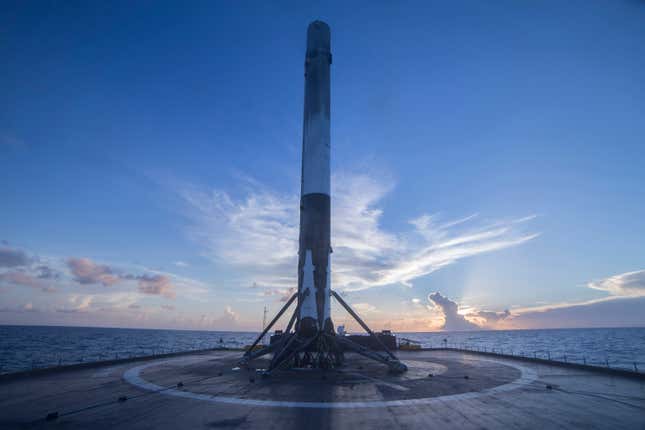
Making reusability a habit
In 2017, SpaceX has recovered every booster it has attempted to land, and re-used two boosters to fly satellites into orbit.
January 14, 2017, Iridium NEXT 1
Flying from Vandenberg Air Force Base in California, this launch marks the first time the company has recovered a stage launched over the Pacific ocean. This rocket would be reused later in the year to launch a satellite for a Bulgarian firm.
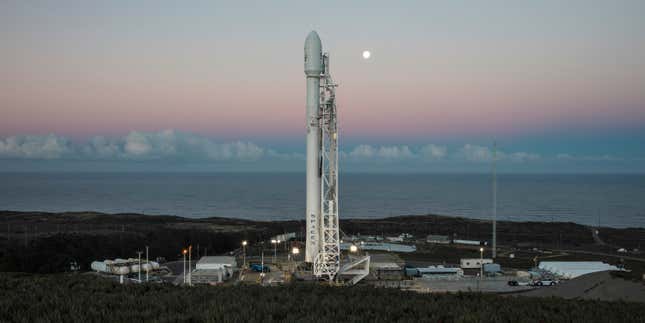
February 19, 2017, CRS-10
Following its first NASA mission of the year, the Falcon 9 flies in for an easy landing at SpaceX’s Cape Canaveral landing pad.
March 30, 2017, SES-10
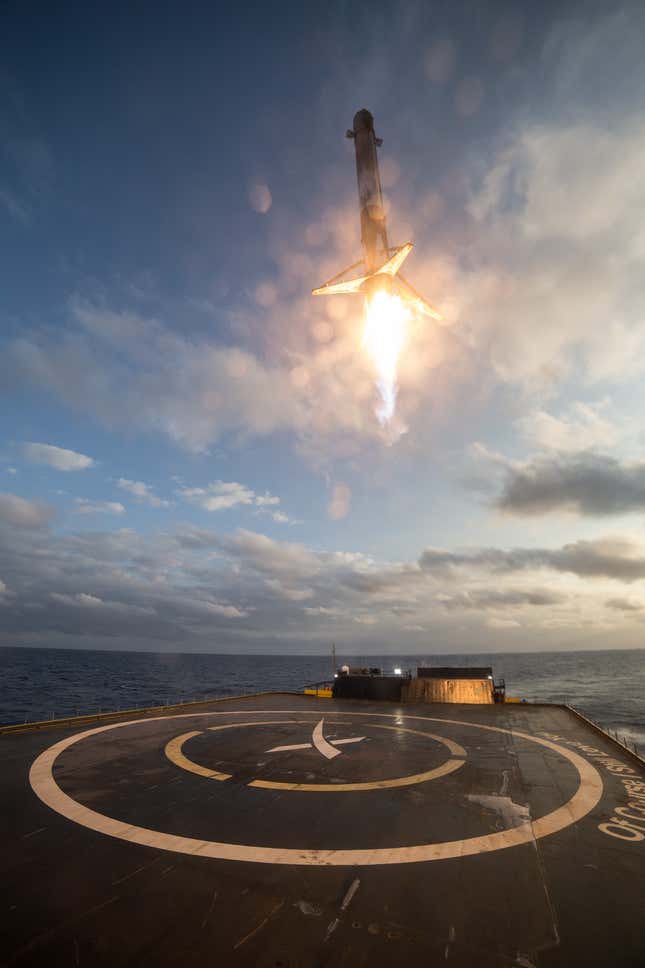
As its landings became increasingly problem-free, it was time for SpaceX to show that it could successfully launch a “flight-proven” first stage and bring it back safely. That would be a major milestone—the culmination of 15 years of work and the final confirmation that it could bring down the cost of launches by reusing rocket boosters.
The rocket it used had previously flown the CRS-8 mission for NASA. After refurbishing it, SpaceX used it to launch a satellite for European space communications giant SES. The launch and return went off without a hitch.
If SpaceX can consistently deliver cheaper launches it will make new business models feasible in orbit and beyond, from space tourism and commercial habitats to mining water on the moon and broadcasting internet from low-earth orbit.
May 1, 2017, NROL-76
A first, not but not for reusability reasons: This was the first time SpaceX flew a national-security payload—in this case a top-secret satellite known as NROL-76, for the US National Reconnaissance Office. After successfully putting the payload in orbit, the rocket’s first stage returned to the landing pad at Cape Canaveral for the third landing at the site.
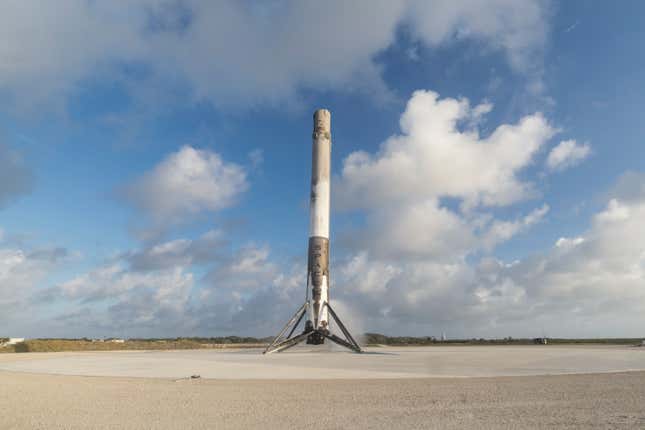
June 3, 2017, CRS-11
Back to work hauling food, gear, and scientific goodies for astronauts orbiting on the ISS. After sending a Dragon spacecraft on its way, the Falcon 9 first stage took a jaunty return flight back to Cape Canaveral.
Not only the Falcon 9 but the Dragon, too, was being reused, taking its second trip to the ISS; the first was in September 2014. After returning to earth with a load of experiments in October 2014, it was recovered, refurbished, and sent back to orbit. It was the first spacecraft to visit the ISS a second time since the shuttle Atlantis in 2011.
June 23, 2017, BulgariaSat
This was the second time SpaceX used a flight-proven first stage to fly a satellite into space. This rocket had first been used in January 2017 to launch a collection of Iridium satellites from Vandenberg Air Force Base in California. After this, its second mission, the rocket landed again on the drone ship, in so doing become the first rocket stage to launch and land over two different oceans.
But because BulgariaSat needed extra thrust to get on its way, there wasn’t much fuel left for a landing, and the stage landed looking a little lopsided. Musk tweeted that much of the collapsible “crush core” in the rocket, like a car’s crumple zone, was expended as it hit the ground.
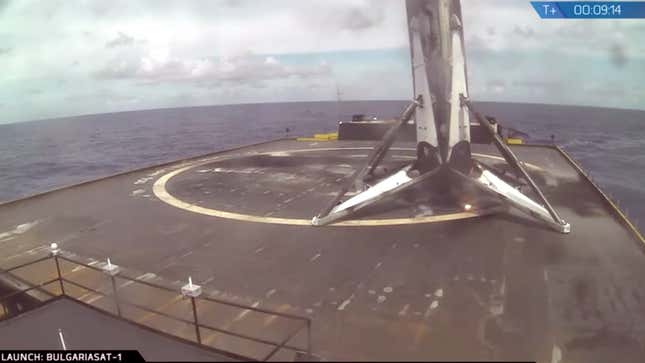
June 25, 2017, Iridium NEXT 2
Despite its recent successes, the company isn’t done improving its technology. One key improvement was seen during the company’s launch of another set of 10 Iridium communications satellites from its California launch site. After on-board video cameras showed that the grid fins were suffering extreme heat damage during re-entry, SpaceX decided to bulk them up. Now they are carved from a single piece of cast titanium to make them more rugged. Their debut on this mission proved their worth, with the third successful recovery of a stage from the Pacific ocean.
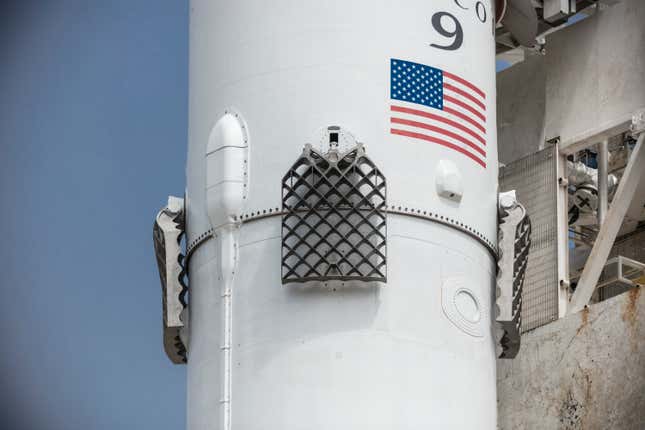
***
And that, so far, is SpaceX’s development of reusable rocket technology.
Still, there is plenty more to come: Musk has mused about reusing the carbon-fiber nosecones that protect satellites during launch, and the second stages that shuttle them from the edge of space to their orbit. The company is also working to make its space capsule, the Dragon, fully reusable. But the real landing show will come next year, when SpaceX expects to debut its Falcon Heavy rocket. The Heavy is essentially three Falcon 9 cores flying strapped together, and SpaceX expects all three to be recovered after they fly—the two side boosters at the Cape Canaveral landing pad, and the central core on a sea-going drone ship.
